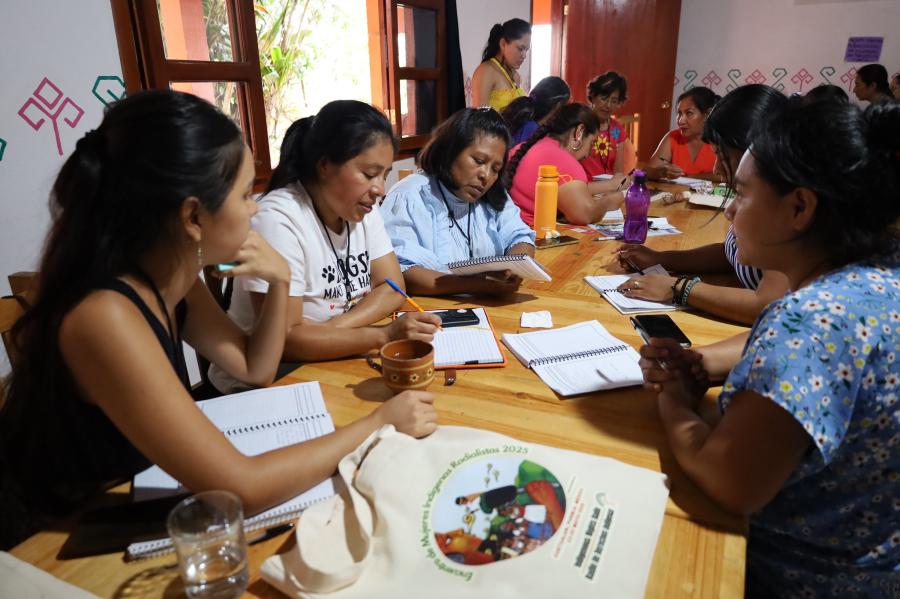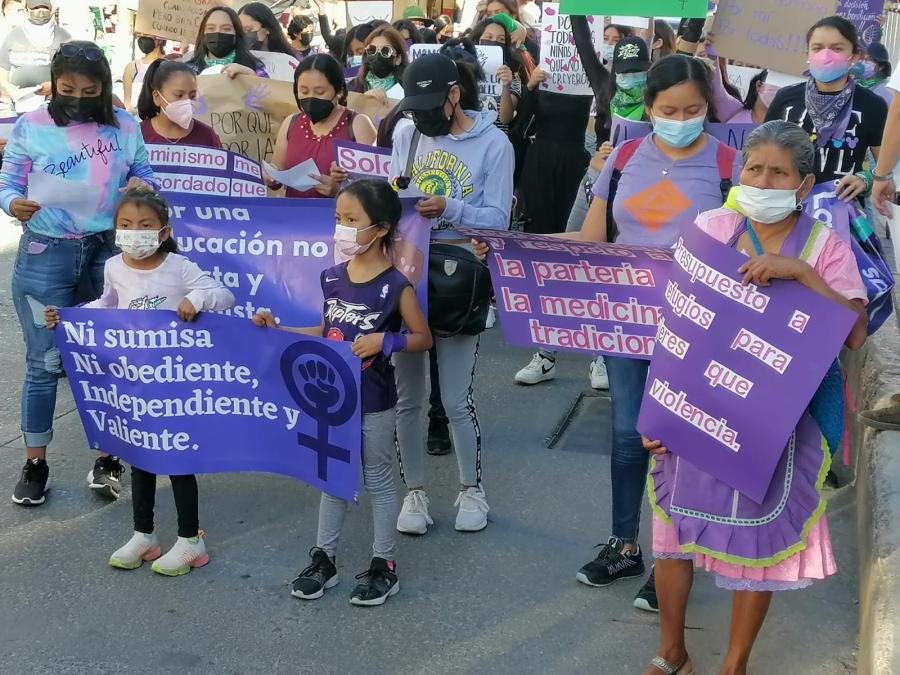Approaching the valley of Nabenchauk from the road, I saw a large concrete structure on the highway and stopped the car. Clothing and other hand-woven textiles hung from every rafter of the open-sided building. It was 1991, and full of uncertainty, I was back in Nabenchauk, a hamlet of the highland Maya community of Zinacantán in Chiapas, Mexico, after an absence of 21 years. In 1970, anthropology student Carla Childs and I, a developmental psychologist, had studied how Zinacantec girls learn to weave. Now we wanted to use weaving as a measuring stick to answer questions about the psychological impact of social and economic change. We were interested in questions of cultural survival and cultural transformation.
Mi liote, I said, “Are you there?” trying out the customary Zinacanteco greeting in my rusty Tzotzil. Mi lione, “I am here,” answered a teen-age girl. I entered the store. I was wearing 1969-model Zinacantec clothes, relics of our earlier field research as part of the Harvard Chiapas Project. The girls taking care of the shop stared, but did not know what to make of me. What I was wearing—a long blue woven cotton skirt, plain white cotton blouse, and a woven red and white striped cotton shawl—bore little resemblance either to what they were selling in their shop, to what gringas usually wear, or, even, to what the Zinacantec girls themselves were wearing.
Hanging from the rafters and racks were a rainbow of acrylics, in bright, even fluorescent, colors with fancy embroidery and decorative woven borders. Special tourist items obviously predominated. When I had last been in Nabenchauk, the only things weavers were willing to give up for sale to tourists were their mistakes. Even more astonishing than what the Zinacantecs were selling to tourists, however, was what they were wearing themselves. My blouse, plain white cotton with a thin line of purple stitching, had spawned progeny with wild geometric or figurative embroidery all over them.
Twenty years earlier, weaving and textile production, along with farming, had lain at the heart of Zinacantec subsistence. Since our departure in 1970, subsistence had clearly expanded into commerce. To build stores and houses on the road, rather than in the protected valley, was a new phenomenon. It symbolized increased commerce with the Spanish-speaking world and the Mexican national economy.
We were there to study how the development of entrepreneurship in the intervening two decades had effected changes in weaving: not only the weaving itself, but the way weaving was taught and learned. Because entrepreneurship requires and encourages innovation, both in practice and as an ideology, I had predicted that pattern innovation and creativity in weaving and embroidery would be one of the spinoffs of entrepreneurial development.
I was now seeing the first confirmation of my prediction. Twenty years earlier all clothing for toddlers up to adults conformed to a closed stock of about four patterns. Now I was seeing the innovation and creativity I had predicted, but the variety and elaboration of the weaving and embroidery went beyond my wildest imagination. I asked which was better, the old or the new. “New” was the answer I always received.
The goal of our research was to link up changes in what was being woven with changes in the way weaving was being learned. In 1970 we had videotaped 14 girls at various stages of learning to weave. Our analysis of the tapes showed that the carefully guided way in which weaving was transmitted from mother to daughter reinforced adherence to and continuity of the basic woven patterns—cultural continuity. Now we needed to find and to study the daughters of our prior weaving learners, to see how they were learning to weave in the new, more commercial and entrepreneurial environment.
We anticipated that weaving learners would become more independent and experimental in the apprenticeship process. Our expectation was confirmed: the daughters, nieces, and godchildren of our original research participants from two decades earlier were indeed learning to weave with less guidance from the older generation and more trial-and-error. Moreover, the change to a more independent style of weaving apprenticeship was concentrated in those families where the mothers and daughters were more actively involved in textile commerce —activities like selling servillettas (used as towels, napkins, and placemats) to outsiders. Economic development had been uneven in the community, and in families that still focused on farming and traditional subsistence activities, the style of learning to weave looked like it had in 1970.
But the culture of backstrap weaving was not just being transformed; it had also survived. How, I wondered, has this weaving tradition been maintained over the centuries? I found the answer in child socialization and development.
The tradition of weaving on the backstrap loom has been securely maintained over the centuries in Zinacantán because a Zinacantec girl’s body and mind are prepared from birth for weaving. At birth, a Zinacantec Maya girl is, through ritual, given a weaving stick. A few years later, she practices kneeling, the weaving position, beside her mother at the hearth. Soon, play weaving on a toy loom begins to provide practice in the concepts and manual skills necessary for “real” weaving.
These long-established mechanisms of cultural transmission have fostered the cultural survival of backstrap-loom weaving, even as it has adapted to new economic conditions. However, developments are taking place in highland Chiapas that could potentially undermine the universality and centrality of backstrap-loom weaving for girls growing up in Nabenchauk.
Indeed, in some nearby Maya communities, such as Chenalho and Mitontik, weaving is no longer universal among girls. These communities have bilingual (Spanish-Tzotzil or Spanish-Tzeltal) schooling with indigenous school teachers and a high rate of girls in school. In Nabenchauk, in contrast, all school teachers are from the outside Ladino (Spanish-speaking Mexican) world, and there is no bilingual education; all schooling takes place in Spanish and most girls never go to school.In Mitontik, Isabel Zambrano’s research shows that girls want to grow up to be teachers, not weavers. In Nabenchauk, however, the ethnic difference between Ladino teachers and Zinacantec families keeps teachers from becoming role models for their students. Some young Nabenchauk weavers told us they had quit school to weave, thus following in the footsteps of their mothers, rather than their teachers. In the words of a bilingual Maya teacher, Elias Perez Perez, “Monolingual teachers don’t penetrate the world of students and their families.”
If bilingual schooling with indigenous teachers, particularly women teachers, ever comes to Nabenchauk, schooling will, I predict, begin to displace the socializing experiences that have maintained backstrap-loom weaving over the millennia. Ultimately, bilingual schooling and Tzotzil-speaking teachers have the power to break the chain of universal transmission of backstrap-loom weaving in Nabenchauk.Patricia Marks Greenfield received her doctorate from Harvard University and is currently a professor of psychology at the University of California-Los Angeles, where she is a member of the FPR-UCLA Center for Culture, Brain, and Development. Her research in Chiapas is the subject of her recent book, Weaving Generations Together: Evolving Creativity in the Maya of Chiapas, published by the School of American Research Press. The book is to be translated into Tzotzil and Spanish by the Sna Jtz’ibajom Maya writers cooperative in Chiapas; it will be the first research monograph translated into Tzotzil. For more information visit www.weaving-generations.com.



